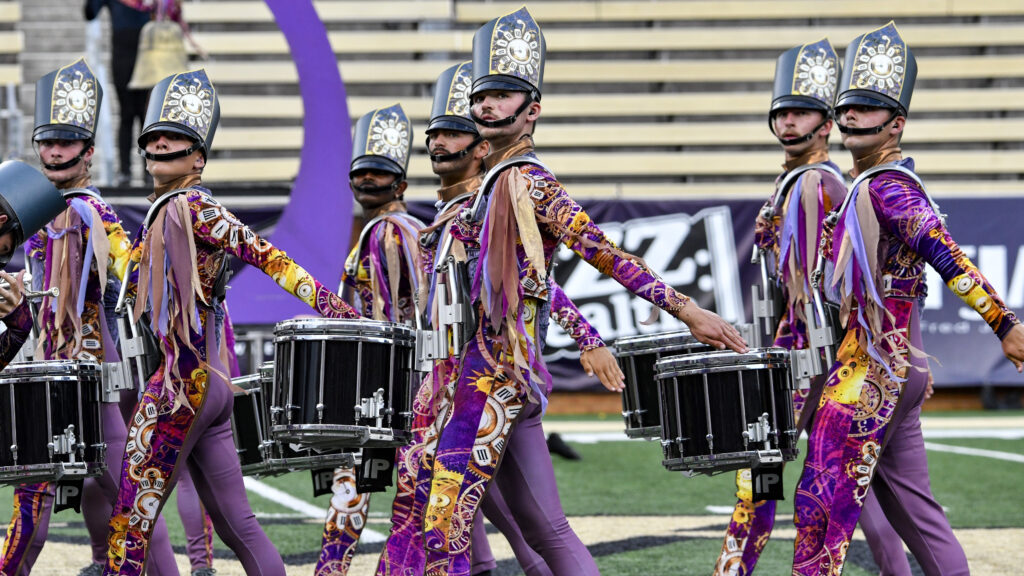For the second consecutive year, the 1989 Drum Corps International World Championships were held at Arrowhead Stadium just outside of Kansas City.
Santa Clara Vanguard won its fifth DCI title with a remake of “Phantom of the Opera” from 1988 and a then-record score of 98.400, ending a four-year streak of second-place finishes. Phantom Regiment finished the season in second place, earning a score that still stands today as the corps’ highest ever.
Garfield Cadets took the field for the frist time as the Cadets of Bergen County, and two corps returned to the Finals competition after an absence the year before. Freelancers returned to the final show of the season after taking 1986 off, and Crossmen returned to the Top 12 after four years out, placing as low as 21st place in 1986.

Finishing in sixth place, Star of Indiana broke into the top half of finalists for the first time, with a score of 95.300 that remains a record for that placement.
The corps’ production explored the glory and pomp of Great Britain, with new British-styled uniforms worn by the brass and percussionists that would be altered dramatically over the coming seasons to fit the theme of each new production.
Though some records note the production title as “British Invasion,” it has generally simply been referred to as “The British Show.” When the corps first hit the field in 1985 it featured Disney music. The next year Star did an outer space theme, followed by a circus show and then “Porgy and Bess.” Director Jim Mason referred to this continual variety of concepts as representing the corps’ “chameleon” nature, a term referencing how the creature changes its colors so rapidly.
Color guard members dressed in two different costumes promoting the different personalities of each of the two sections. While Mason referred to these as the articulate guard and the lyrical guard, the corps members referred to the two groups as Redcoats and Highlanders.
The Redcoats were dressed in prim and proper uniforms resembling foxhunt costumes with trousers. They looked stern most of the time and often didn’t smile throughout the production. The Highlanders, dressed in more carefree tartan skirts and ruffled blouses, seemed to smile constantly.
Over the years, the color guard became known for creating homemade equipment, such as the Redcoats’ maces in the closer that were made of PVC pipe wrapped in shiny tape with a ball on the end, also covered in tape.

The show visited the regal musings of British composers William Walton and Gustav Holst.
It opened with “Prologue” from Walton’s “Henry V,” a 1944 movie for which the composer drew upon material written during Shakespeare’s day. The musical aura of this piece was all about pomp and a proclamation of Britain ruling the waves, the world, and the known universe. It was a musical poster of Britain’s eternal place of dominance as seen from the perspective of the time of Henry V’s rule from 1413 to 1422.
Coat of arms clad shields dotted the front sideline as elongated diagonal boxes split apart and re-formed as diagonal boxes in the opposite direction, soon ending in a company front formation.
The second segment of the show was dedicated to Holst’s “Song Without Words,” the second movement of his 1911 “Second Suite in F for Military Band.” This was one segment of the show where the two sections of color guard were mixed together alternately, with flags of the same design.

To promote the image of the guard being one entity, the Redcoats broke character and smiled. At the end of the piece, a four-point formation of brass players spread apart, with the percussionists collapsing into an upside-down “V” at the top, and ultimately forming the corps’ familiar five-point star.
The third selection of the show was Holst’s “Fantasia on the Dargason,” the fourth and final movement from “Second Suite.” The composer based this movement on two selections from a 1651 manual of English country dances. The fantasia started with “Dargason,” based on an old English term for dwarf or fairy. Later, the famous melody “Greensleeves” was woven in with the first melody.
The Highlanders danced a jig during the beginning of this piece, which largely served as the percussion feature. The serenity of a traditional English garden served as the inspiration for the corps’ treatment of the musical selection, and visually the entire color guard section spun flags with the image of a butterfly to underscore the theme.
When the brass players resumed playing for the “Greensleeves” segment, the upper voices formed a line down the 50-yard line and the lower voices formed two “V” forms projecting out from each side of the 50. It snuck past a lot of people, but this created a simple form of a butterfly.

The piece ended with a company front formation that grew out of the two segments of brass playing and marching the two melodies in different tempos.
Walton’s regal “Crown Imperial,” an orchestral march written in 1937 and premiered at the coronation of King George VI, father to Queen Elizabeth II, served as the corps’ closer.
With great bravado in the second half of the segment, the horn line sounded very much like a grand pipe organ. The brashness of the brass turned up even higher as another company front formation dissolved, re-formed, and dissolved again into the final form of the show, proclaiming once and for all the pride of British rule.
1989 Overview

Michael Boo was a member of the Cavaliers from 1975-1977. He wrote about the drum corps activity for more than 35 years while serving as a staff writer for various Drum Corps International projects. During his lifetime Boo wrote for numerous other publications including an honors-winning book on the history of figure skating. He also was an accomplished composer. Boo passed away in 2020 and was inducted into the DCI Hall of Fame posthumously in 2021.





